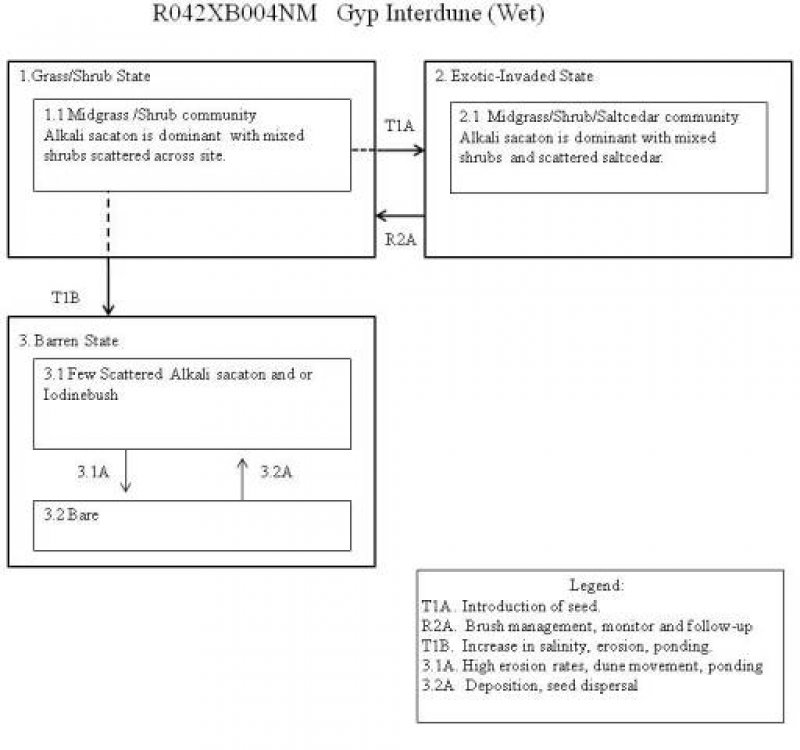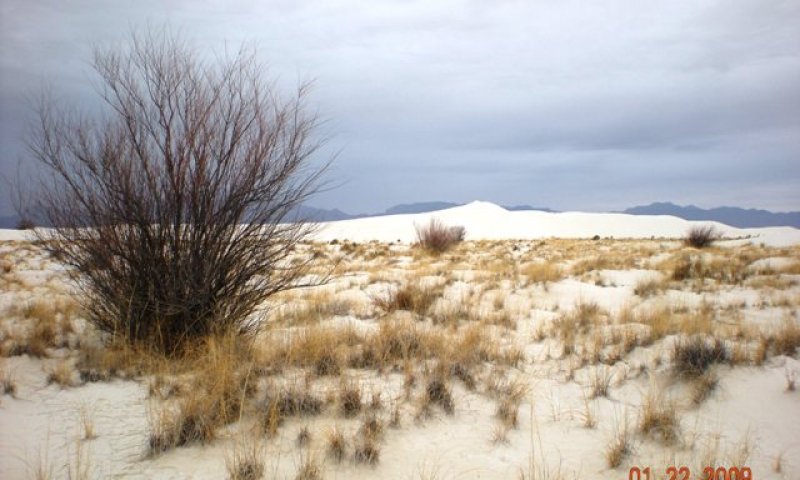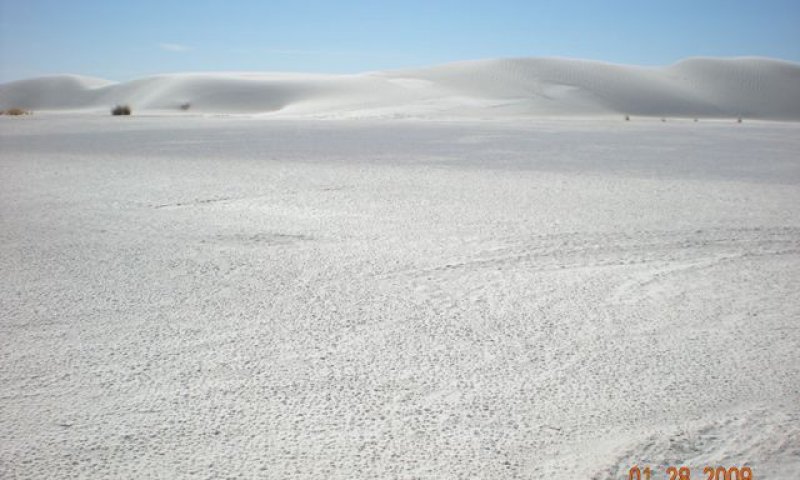

Natural Resources
Conservation Service
Ecological site R042BB004NM
Gyp Interdune (Wet), Desert Shrub
Accessed: 12/19/2025
General information
Provisional. A provisional ecological site description has undergone quality control and quality assurance review. It contains a working state and transition model and enough information to identify the ecological site.
Figure 1. Mapped extent
Areas shown in blue indicate the maximum mapped extent of this ecological site. Other ecological sites likely occur within the highlighted areas. It is also possible for this ecological site to occur outside of highlighted areas if detailed soil survey has not been completed or recently updated.
Ecological site concept
This Ecological Site (ES) occurs excusively on Whitesands National Monument and Whitesands Missile Range properties which are located within the Tulerosa basin. ES characteristics are found in the interdunes of barchnoid dunes. Where interdune has a watertable that fluctuates seasonally from surface to a few feet from soil surface. Facultative wet herbaceous vegetation occurs on this site. As one travels in the direction of the prevaling wind (SW to NE) along the Dunefield, this wet interdune ES is situated predominately prior to deflated barchnoid dune and barial of the interdune.
Associated sites
| R042BB002NM |
Gyp Duneland Barren, Desert Shrub The Gyp Interdune (wet) ecological site is associated with the Gyp Duneland Barren ecological site. They occur in association and can change places spatially as the dunes migrate downwind across the interdune. |
|---|
Table 1. Dominant plant species
| Tree |
(1) Populus fremontii |
|---|---|
| Shrub |
(1) Yucca elata |
| Herbaceous |
(1) Sporobolus airoides |
Physiographic features
This site occurs as the interdunal areas within the barchanoid type dunefields. During years with unusually high precipitation these interdunes may pond water for varying periods of time. Slope of the interdune landform averages 0 to 3 percent. Elevation ranges from approximately 3900 to 4200 feet above sea level.
Table 2. Representative physiographic features
| Landforms |
(1)
Interdune
|
|---|---|
| Flooding frequency | None |
| Ponding duration | Very brief (4 to 48 hours) to long (7 to 30 days) |
| Ponding frequency | Rare to occasional |
| Elevation | 3,900 – 4,200 ft |
| Slope | 3% |
| Water table depth | 40 in |
| Aspect | Aspect is not a significant factor |
Climatic features
Annual average precipitation ranges from 7 to 12 inches. Wide fluctuations from year to year are common. At least one-half of the annual precipitation comes in the form of rainfall during July, August, and September. Precipitation in the form of snow or sleet averages less than 4 inches annually. The average annual air temperature is about 60 degree F. Summer maximums can exceed 100 degrees F. and winter minimums can go below zero. The average frost-free season exceeds 200 days and extends from April 1 to November 1. Both the temperature regime and rainfall distribution favor warm-season perennial plants on this site. Spring moisture conditions are only occasionally adequate to cause significant growth during this period of year. High winds from the west and southwest are common from March to June, which further tends to create poor soil moisture conditions in the springtime
Climate data was obtained from
http://www.wrcc.dri.edu/summary/climsmnm.html
Table 3. Representative climatic features
| Frost-free period (average) | 205 days |
|---|---|
| Freeze-free period (average) | 227 days |
| Precipitation total (average) | 12 in |
Figure 2. Monthly precipitation range
Figure 3. Monthly average minimum and maximum temperature
Influencing water features
This site is not influenced by water from a wetland or stream.
The interdunes have a water table that averages 30 to 40 inches in depth. During years that experience above average precipitation, water may pond for periods of several days to several weeks.
Soil features
The surface and underlying soils of this site are white gypsiferous sands. Depth to the water table averages 30 to 40 inches, but fluctuates seasonally. The soils are strongly saline and exhibit very rapid permeability.
Characteristic Soils:
NM-688 MU-426 Transformer-Duneland Association, 0-90 percent slopes
NM-688 MU-427 Duneland-Transformer Association, 0-90 percent slopes
Table 4. Representative soil features
| Parent material |
(1)
Eolian sands
–
rock gypsum
(2) Eolian deposits – rock gypsum |
|---|---|
| Surface texture |
(1) Gypsiferous sand |
| Family particle size |
(1) Sandy |
| Drainage class | Moderately well drained to somewhat poorly drained |
| Permeability class | Very rapid |
| Soil depth | 80 in |
| Surface fragment cover <=3" | Not specified |
| Surface fragment cover >3" | Not specified |
| Available water capacity (0-40in) |
2.8 – 3 in |
| Electrical conductivity (0-40in) |
15 – 24 mmhos/cm |
| Soil reaction (1:1 water) (0-40in) |
8 – 8.5 |
| Subsurface fragment volume <=3" (Depth not specified) |
Not specified |
| Subsurface fragment volume >3" (Depth not specified) |
Not specified |
Ecological dynamics
Overview:
Plant community composition, distribution, and production within the interdunes are controlled by numerous factors. Some of which include depth to ground water, quality and amount of water, and the erosional and depositional effects of wind.
Changes from a grass/shrub state to a barren state may be initiated by ponding, an increase in amount of salts present on the site and or changes in wind flow patterns. Salts can accumulate on the surface of the Interdunes by the evaporation of shallow saline groundwater brought near the surface via capillary rise. Wind erosion can inhibit seedling establishment and can create interdune surfaces with features that enhance capillary rise. The grassland state of this ecological site is susceptible to invasion by saltcedar. Domination of the interdune by saltcedar is unlikely due to shallow depth to water. Saltcedar establishing on the interdunes can act as a seed source for the associated dunes, and adjoining areas.
State and transition model

More interactive model formats are also available.
View Interactive Models
More interactive model formats are also available.
View Interactive Models
Click on state and transition labels to scroll to the respective text
Ecosystem states
State 1 submodel, plant communities
State 2 submodel, plant communities
State 3 submodel, plant communities
State 1
Grass / Shrub
This state is mix of midgrasses and various shrubs. This state tends to occur where the interdunes are least susceptible to ponding and increased salts. Plant densities also tend to be higher on the narrower interdunes and in the protected areas near the leeward side of the associated barchanoid dunes.
Community 1.1
Midgrass-Shrub community

Figure 4. Midgrass/Shrub

Figure 5. Midgrass/Shrub 2

Figure 6. Transformer Soil Pit
This community type is common on many of the interdunes within the barchanoid dunefields. Alkali sacaton is the dominant grass species. Other common grasses include Indian ricegrass, and New Mexico bluestem. Typical shrubs include ephedra, Trans-Pecos false clapdaisy, yucca, and rabbitbrush.
Figure 7. Annual production by plant type (representative values) or group (midpoint values)
Table 5. Annual production by plant type
| Plant type | Low (lb/acre) |
Representative value (lb/acre) |
High (lb/acre) |
|---|---|---|---|
| Grass/Grasslike | 90 | 245 | 360 |
| Shrub/Vine | 20 | 110 | 175 |
| Forb | 35 | 55 | 95 |
| Total | 145 | 410 | 630 |
State 2
Exotic-Invaded State
The presence of saltcedar characterizes this state. Saltcedar densities are typically low, occurring as widely scattered individual plants.
Community 2.1
Midgrass/Shrub/Saltcedar

Figure 8. Saltcedar-Invaded
This community type is typically composed of alkali sacaton and various shrubs with saltcedar occurring as a minor component. Other grasses can include Indian ricegrass, NM bluestem, and sandhill muhly. Shrubs include yucca, ephedra, skunkbush sumac, frosted mint, and rabbitbrush.
State 3
Barren
This state is characterized by the lack of, or very sparse vegetation. Species if present usually consist of widely scattered alkali sacaton, and/or Iodinebush. These areas are subject to ponding following high intensity rainfall events.
Community 3.1
Sparse Sacaton/Iodinebush

Figure 9. Sparse Sacaton/Iodinebush
This community phase is typically composed of a sparse cover of alkali sacaton and or Iodinebush. Salinity levels probably help to limit species diversity within the community. This community phase often intergrades with the bare phase and may represent the topographic high spots within the interdunes.
Community 3.2
Bare

Figure 10. Bare
This community phase is characterized by the lack of vegetation.
Pathway 3.1A
Community 3.1 to 3.2


The community pathway to a bare or non vegetated community is believed to result from extensive erosion. This may be due in part to the orientation and size of the interdunes and associated dunes, and or actual dune movement. Additionally, extended periods of water ponding within the interdune may also cause this community pathway.
Pathway 3.2A
Community 3.2 to 3.1


Seed dispersal from adjoining sites may provide a pathway from the bare community phase to a sparsely vegetated community. Deposition of gypsiferous sands across the interdune may favor seedling germination and survival.
Transition T1A
State 1 to 2
Introduction of seed is the primary factor in the cause of this transition. Due to the presence of a shallow water table, soils on this site usually contain adequate soil moisture necessary for seed germination. Ironically this shallow depth to water may naturally inhibit domination by saltcedar. Saltcedar seem to dominate on soils where depth to the water table is between 5 and 18 feet from the surface. Locations adjacent to areas with an abundant seed source or underground streams may also increase the likelihood of this transition.
Restoration pathway R2A
State 2 to 1
Brush management by chemical, mechanical or a combination can be used to remove saltcedar and return to the Grass/Shrub state. Manually removing and treating the cut stumps with“Garlon” is effective in the treatment of saltcedar. Additionally, spraying with “Arsenal” also has exhibited high kill rates. Regardless of the means of treatment, monitoring and follow-up will be necessary to insure missed plants and regrowth is addressed.
Additional community tables
Table 6. Community 1.1 plant community composition
| Group | Common name | Symbol | Scientific name | Annual production (lb/acre) | Foliar cover (%) | |
|---|---|---|---|---|---|---|
|
Grass/Grasslike
|
||||||
| 1 | Warm season Mid/Tall grasses | 80–325 | ||||
| alkali sacaton | SPAI | Sporobolus airoides | 80–250 | – | ||
| little bluestem | SCSCS | Schizachyrium scoparium var. scoparium | 0–75 | – | ||
| 2 | Cool season short grasses | 10–35 | ||||
| Indian ricegrass | ACHY | Achnatherum hymenoides | 10–35 | – | ||
|
Forb
|
||||||
| 3 | Forbs | 35–95 | ||||
| greenthread | THELE | Thelesperma | 15–40 | – | ||
| purple sand verbena | ABAN | Abronia angustifolia | 15–35 | – | ||
| Forb, annual | 2FA | Forb, annual | 5–15 | – | ||
| Forb, perennial | 2FP | Forb, perennial | 5–15 | – | ||
|
Shrub/Vine
|
||||||
| 4 | Shrubs | 15–145 | ||||
| Trans-Pecos false clapdaisy | PSAR | Pseudoclappia arenaria | 0–45 | – | ||
| Torrey's jointfir | EPTO | Ephedra torreyana | 10–40 | – | ||
| rabbitbrush | CHRYS9 | Chrysothamnus | 0–25 | – | ||
| James' seaheath | FRJA | Frankenia jamesii | 0–10 | – | ||
| 5 | Succulents | 5–30 | ||||
| Shrub (>.5m) | 2SHRUB | Shrub (>.5m) | 5–30 | – | ||
| soaptree yucca | YUEL | Yucca elata | 5–30 | – | ||
Interpretations
Animal community
Characteristic wildlife includes little striped whiptail, White Sands prairie lizard, bleached earless lizard, spadefoot toad, Apache pocket mouse, White sands woodrat, spotted ground squirrel, camel cricket, tiger beetle, lycosid spider, and scorpions. Ord’s kangaroo rat and spotted ground squirrel are also common to this site.
Hydrological functions
The dunefields and interdunes exhibit a relatively shallow ground water table. The water table depth varies seasonally and depending on precipitation and season ranges from the surface to a few feet deep. The shallow groundwater controls dune sediment accumulation. Additionally the moisture helps to stabilize the sediments resisting erosion and movement.
Recreational uses
This site and the associated Gypsum dune sites currently provide extensive recreational opportunities on the White Sands National Monument, and Guadalupe State Park. Where this site occurs on White Sands Missile Range access is restricted.
Wood products
This site provides no significant wood products.
Other products
Gypsum
Supporting information
Type locality
| Location 1: Otero County, NM | |
|---|---|
| UTM zone | N |
| UTM northing | 3640218 |
| UTM easting | 381789 |
| General legal description | Otero Co. 13.3 miles east and 1.6 miles north of junction of range roads 7&10 |
Other references
Other References:
Bennett, J., Wilder, D., 2009. Physical resources foundation report, White Sands National Monunent, Natural Resource Report NPS/NRPC/NRR—2009/166. National Park Service, Fort Collins, Colorado.
Di Tomaso, J. M., 1998. Impact, Biology, and Ecology of Saltcedar (Tamarix spp.) in the Southwestern United States. Weed Technology. 12: 326-336.
Fryberger, S.G., 2000. Geological overview of White Sands National Monument. http://www.nature.nps.gov/geology/parks/whsa/geows/index.htm
Kocurek, G., Carr, M.,Ewing, R., Havholm, K.G., Nagar, Y.C., Singhvi, a.K. 2007. White Sands Dune Field, New Mexico: Age, dune dynamics and recent accumulations. Sedimentaty Geology 197 (2007) 313-331
Langford, R.P., Rose, J.M., White, D.E., 2009. Groundwater salinity as a control on development of eolian landscape: An example from White Sands of New Mexico. Geomorphology 105(2009) 39-49.
Muldavin, E., Chauvin, Y., Harper, G., 2000 The Vegetation of White Sands Missile Range, New Mexico. Volume 1: Handbook of Vegetation Communities. Final Report, New Mexico Natural Heritage Program. University of New Mexico. Albuquerque, New Mexico.
Contributors
David Trujillo
Rangeland health reference sheet
Interpreting Indicators of Rangeland Health is a qualitative assessment protocol used to determine ecosystem condition based on benchmark characteristics described in the Reference Sheet. A suite of 17 (or more) indicators are typically considered in an assessment. The ecological site(s) representative of an assessment location must be known prior to applying the protocol and must be verified based on soils and climate. Current plant community cannot be used to identify the ecological site.
| Author(s)/participant(s) | |
|---|---|
| Contact for lead author | |
| Date | |
| Approved by | |
| Approval date | |
| Composition (Indicators 10 and 12) based on | Annual Production |
Indicators
-
Number and extent of rills:
-
Presence of water flow patterns:
-
Number and height of erosional pedestals or terracettes:
-
Bare ground from Ecological Site Description or other studies (rock, litter, lichen, moss, plant canopy are not bare ground):
-
Number of gullies and erosion associated with gullies:
-
Extent of wind scoured, blowouts and/or depositional areas:
-
Amount of litter movement (describe size and distance expected to travel):
-
Soil surface (top few mm) resistance to erosion (stability values are averages - most sites will show a range of values):
-
Soil surface structure and SOM content (include type of structure and A-horizon color and thickness):
-
Effect of community phase composition (relative proportion of different functional groups) and spatial distribution on infiltration and runoff:
-
Presence and thickness of compaction layer (usually none; describe soil profile features which may be mistaken for compaction on this site):
-
Functional/Structural Groups (list in order of descending dominance by above-ground annual-production or live foliar cover using symbols: >>, >, = to indicate much greater than, greater than, and equal to):
Dominant:
Sub-dominant:
Other:
Additional:
-
Amount of plant mortality and decadence (include which functional groups are expected to show mortality or decadence):
-
Average percent litter cover (%) and depth ( in):
-
Expected annual annual-production (this is TOTAL above-ground annual-production, not just forage annual-production):
-
Potential invasive (including noxious) species (native and non-native). List species which BOTH characterize degraded states and have the potential to become a dominant or co-dominant species on the ecological site if their future establishment and growth is not actively controlled by management interventions. Species that become dominant for only one to several years (e.g., short-term response to drought or wildfire) are not invasive plants. Note that unlike other indicators, we are describing what is NOT expected in the reference state for the ecological site:
-
Perennial plant reproductive capability:
Print Options
Sections
Font
Other
The Ecosystem Dynamics Interpretive Tool is an information system framework developed by the USDA-ARS Jornada Experimental Range, USDA Natural Resources Conservation Service, and New Mexico State University.
Click on box and path labels to scroll to the respective text.